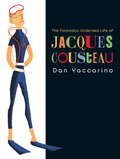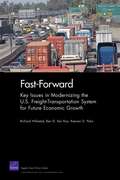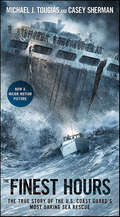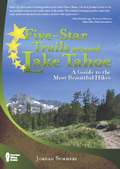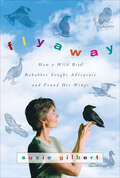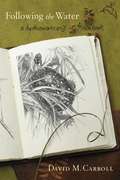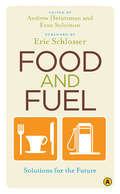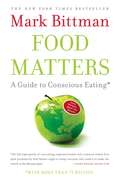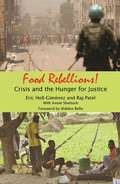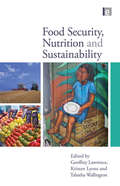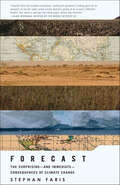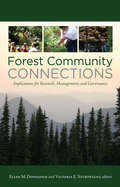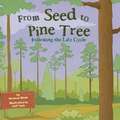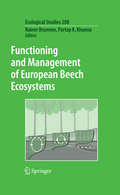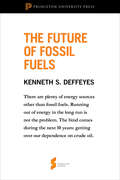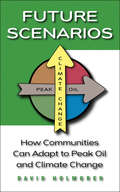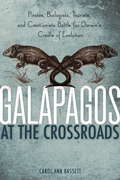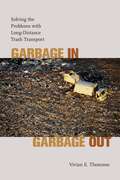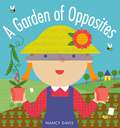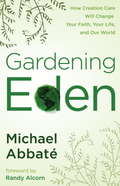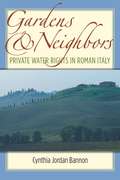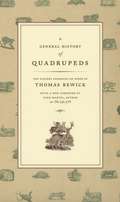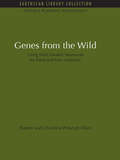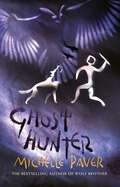- Table View
- List View
The Fantastic Undersea Life of Jacques Cousteau
by Dan YaccarinoJacques Cousteau was the world's ambassador of the oceans. His popular TV series brought whales, otters, and dolphins right into people's living rooms. Now, in this exciting picturebook biography, Dan Yaccarino introduces young readers to the man behind the snorkel.From the first moment he got a glimpse of what lived under the ocean's waves, Cousteau was hooked. And so he set sail aboard the Calypso to see the sea. He and his team of scientists invented diving equipment and waterproof cameras. They made films and televisions shows and wrote books so they could share what they learned. The oceans were a vast unexplored world, and Cousteau became our guide. And when he saw that pollution was taking its toll on the seas, Cousteau became our guide in how to protect the oceans as well.
Fast-Forward
by Ben D. Van Roo Keenan D. Yoho Richard HillestadEfficient movement of freight within the United States and across its borders is a critical enabler of future U.S. economic growth. The authors provide an overview of the freight-transportation system and the problems it faces, concluding with a discussion of key system-modernization issues, including increasing capacity, making the system less vulnerable to disruption, addressing environmental concerns, and building support for funding.
The Finest Hours: The True Story of the U.S. Coast Guard's Most Daring Sea Rescue (True Rescue Chapter Bks.)
by Michael J. Tougias Casey ShermanThe story behind the major motion picture from Disney—starring Chris Pine, Eric Bana, and Casey Affleck—written by a recognized master of the genre—&“a blockbuster account of tragedy at sea&” (The Providence Journal).It&’s the winter of 1952 and a ferocious Nor&’easter is pounding New England with howling winds and seventy-foot seas. Two oil tankers get caught in the violent storm off Cape Cod, its fury splitting the massive ships in two. Back on shore are four young Coast Guardsmen who are given a suicide mission. They must save the lives of the seamen left stranded in the killer storm, and they have to do it in a tiny lifeboat. The crew is led by Bernie Webber, who has to rely on prayer and the courage of his three crewmembers to pull off the impossible. As Webber and his crew sail into the teeth of the storm, each man comes to the realization that he may not come back alive. They&’ve lost all navigation and have no idea where the stranded seaman are, and have no idea how to get back home. Whether by sheer luck or divine intervention, the crew stumbles upon the wounded ship in the darkness. More than thirty men appear at the railings of the SS Pendleton, all hoping to be saved. Once again, Webber and his crew face a daunting challenge. How can they rescue all these men with their tiny lifeboat?Dripping with suspense and high-stakes human drama, The Finest Hours has incredible and astonishing true-to-life heroism and action-packed rescue scenes. This &“marvelous and terrifying yarn&” (Los Angeles Times) &“deserves a place as a classic of survival at sea&” (The Boston Globe).
Five-Star Trails around Lake Tahoe
by Jordan SummersCovering the region surrounding the 22-mile long lake, author Jordan Summers guides hikers along 40 of the region's best trails - all located within 25 miles of Lake Tahoe's shoreline.Trekkers can easily find the perfect hike with the complete trail descriptions for 27 dayhike and 13 overnight destinations. An accurate map, directions to the trailhead with coordinates for GPS use, and an elevation profile of each trail prepare hikers with the full picture of the route ahead.Generally intended for outdoors-people of all ages and abilities, Five-Star Trails around Lake Tahoe describes great hikes from the Desolation, Mt. Rose, Granite Chief, and Mokelumne Wilderness areas and along sections of the Pacific Crest National Scenic Trail and portions of the Tahoe Rim Trail. While ranging across forest- and granite-covered terrain to over a dozen peaks and several dozen lakes, hike profiles include details on natural history, geologic features, and places of historic note.With Five-Star Trails around Lake Tahoe, hikers will follow in the footsteps of pioneers such as Kit Carson and the historic Donner Party along the Pony Express Trail and the Emigrant Trail, often with stunning vistas of Lake Tahoe, Emerald Bay, Fallen Leaf Lake, or the Crystal Range.
Flyaway: How A Wild Bird Rehabber Sought Adventure and Found Her Wings
by Suzie Gilbert“A delightful must-read…. It charms, delights, and educates while providing a fascinating tale of love and devotion to the feathered creatures that share our increasingly crowded world.” — Joanna Burger, author of The Parrot Who Owns Me“Gilbert’s ethics and talent for writing have made her the perfect author to bring the world of wildlife rehabilitation to the reader.” — Wilson JournalIn this captivating memoir, Suzie Gilbert tells the rollicking story of how she turned her family life upside down to pursue her unusual passion for rehabilitating wild birds. Fans of Michael Pollan, James Herriot, and Elizabeth Marshal Thomas are sure to find much to cherish in Flyaway.
Following the Water: A Hydromancer's Notebook
by David M. CarrollThe writer, naturalist, and artist David Carroll illuminates the ecology and life histories the tree frogs, hawks, foxes, and the increasingly rare wood and spotted turtles he has been tracking for decades with the precision and passion that won him a 2006 MacArthur "genius" award.Following theWater is the intensely observed chronicle of Carroll's annual March-to-November wetlands immersion-from the joy of the first turtle sighting in March to the gorgeously described, vibrant trilling of tree frogs ("lichen with eyes") in late May to the ancient sense of love and loss Carroll experiences each autumn when it is time once again to part with open water.Illustrated with the author's fine pen-and-ink drawings, Following theWater is a gorgeous evocation of nature, an utterly unique "admission ticket to a secret corner of the world" (Bill McKibben).
Food and Fuel: Solutions for the Future
by Andrew Heintzman Evan SolomonThe twenty-first century has been dominated by two major global crises: a scarcity of food and fuel. Both have had detrimental effects on the environment and both are at the root of the fragile health of the global economy. Combining the best of the critically acclaimed Fuelling the Future and Feeding the Future, this timely and provocative collection of essays from leading thinkers such as Thomas Homer-Dixon, Gordon Laird, Jeremy Rifkin, Frances Moore Lappe, and Anna Lappe offers valuable strategies to combat global famine and fast-food fat; business models for sustainable food production and power sources; and descriptions of emerging technologies and sciences.
Food Matters: A Guide to Conscious Eating with More than 75 Recipes
by Mark BittmanFrom the award-winning champion of culinary simplicity who gave us the bestselling How to Cook Everything and How to Cook Everything Vegetarian comes Food Matters, a plan for responsible eating that's as good for the planet as it is for your weight and your health. We are finally starting to acknowledge the threat carbon emissions pose to our ozone layer, but few people have focused on the extent to which our consumption of meat contributes to global warming. Think about it this way: in terms of energy consumption, serving a typical family-of-four steak dinner is the rough equivalent of driving around in an SUV for three hours while leaving all the lights on at home. Bittman offers a no-nonsense rundown on how government policy, big business marketing, and global economics influence what we choose to put on the table each evening. He demystifies buzzwords like "organic," "sustainable," and "local" and offers straightforward, budget-conscious advice that will help you make small changes that will shrink your carbon footprint--and your waistline. Flexible, simple, and non-doctrinaire, the plan is based on hard science but gives you plenty of leeway to tailor your food choices to your lifestyle, schedule, and level of commitment. Bittman, a food writer who loves to eat and eats out frequently, lost thirty-five pounds and saw marked improvement in his blood levels by simply cutting meat and processed foods out of two of his three daily meals. But the simple truth, as he points out, is that as long as you eat more vegetables and whole grains, the result will be better health for you and for the world in which we live. Unlike most things that are virtuous and healthful, Bittman's plan doesn't involve sacrifice. From Spinach and Sweet Potato Salad with Warm Bacon Dressing to Breakfast Bread Pudding, the recipes in Food Matters are flavorful and sophisticated. A month's worth of meal plans shows you how Bittman chooses to eat and offers proof of how satisfying a mindful and responsible diet can be. Cheaper, healthier, and socially sound, Food Matters represents the future of American eating.
Food Rebellions
by Eric Holt-Gimenez Raj PatelToday there are over a billion hungry people on the planet, more than ever before in history. While the global food crisis dropped out of the news in 2008, it returned in 2011 (and is threatening us again in 2012) and remains a painful reality for the world's poor and underserved. Why, in a time of record harvests, are a record number of people going hungry? And why are a handful of corporations making record profits? In Food Rebellions! Crisis and the Hunger for Justice, authors Eric Holt-Giménez and Raj Patel with Annie Shattuck offer us the real story behind the global food crisis and document the growing trend of grassroots solutions to hunger spreading around the world.Food Rebellions! contains up to date information about the current political and economic realities of our food systems. Anchored in political economy and an historical perspective, it is a valuable academic resource for understanding the root causes of hunger, growing inequality, the industrial agri-foods complex, and political unrest. Using a multidisciplinary approach, Holt-Giménez and Patel give a detailed historical analysis of the events that led to the global food crisis and document the grassroots initiatives of social movements working to forge food sovereignty around the world. These social movements and this inspiring book compel readers to confront the crucial question: Who is hungry, why, and what can we do about it?
Food Security, Nutrition and Sustainability
by Geoffrey Lawrence Kristen Lyons Tabatha WallingtonAs the threats of food insecurity loom ever larger, the world faces the sad irony of food shortages in the global South alongside a purported 'obesity epidemic' in the global North. The twin issues of food production and food access are of particular concern in the context of climate change, 'peak oil', biofuels, and land grabs by wealthy nations. Food Security, Nutrition and Sustainability offers critical insights by international scholars, with chapters on global food security, supermarket power, new technologies, and sustainability. The book also assesses the contributions of diet and nutrition research in building socially just and environmentally sustainable food systems and provides policy recommendations to improve the health and environmental status of contemporary agri-food systems. The book features contributions from a range of social science perspectives, including sociology, anthropology, public health and geography, with case study material drawn from throughout the world.
Forecast: The Surprising—and Immediate—Consequences of Climate Change
by Stephan FarisA vivid and illuminating portrayal of the surprising ways that climate change will affect the world in the near future—politically, economically, and culturallyWhile reporting just outside of Darfur, Stephan Faris discovered that climate change was at the root of that conflict, and began to wonder what current and impending—and largely unanticipated—crises such changes have in store for the world. Forecast provides the answers.Global warming will spur the spread of many diseases. Italy has already experienced its first climate-change epidemic of a tropical disease, and malaria is gaining ground in Africa. The warming world will shift huge populations and potentially redraw political alliances around the globe, driving environmentalists into the hands of anti-immigrant groups. America's coasts are already more difficult places to live as increasing insurance rates make the Gulf Coast and other gorgeous spots prohibitively expensive. Crops will fail in previously lush places and thrive in some formerly barren zones, altering huge industries and remaking traditions. Water scarcity in India and Pakistan have the potential to inflame the conflict in Kashmir to unprecedented levels and draw the United States into the troubles there, and elsewhere.Told through the narratives of current, past, and future events, the result of astonishingly wide travel and reporting, Forecast is a powerful, gracefully written, eye-opening account of this most urgent issue and how it has altered and will alter our world.
Forest Community Connections: "Implications for Research, Management, and Governance"
by Ellen M Donoghue Victoria E SturtevantThe connections between communities and forests are complex and evolving, presenting challenges to forest managers, researchers, and communities themselves. Dependency on timber extraction and timber-related industries is no longer a universal characteristic of the forest community. Remoteness is also a less common feature, as technology, workforce mobility, tourism, and 'amenity migrants' increasingly connect rural to urban places. Forest Community Connections explores the responses of forest communities to a changing economy, changing federal policy, and concerns about forest health from both within and outside forest communities. Focusing primarily on the United States, the book examines the ways that social scientists work with communities-their role in facilitating social learning, informing policy decisions, and contributing to community well being. Bringing perspectives from sociology, anthropology, political science, and forestry, the authors review a range of management issues, including wildfire risk, forest restoration, labor force capacity, and the growing demand for a growing variety of forest goods and services. They examine the increasingly diverse aesthetic and cultural values that forest residents attribute to forests, the factors that contribute to strong and resilient connections between communities and forests, and consider a range of governance structures to positively influence the well being of forest communities and forests, including collaboration and community-based forestry.
Framing Discourse on the Environment: A Critical Discourse Approach (Routledge Critical Studies in Discourse)
by Richard AlexanderIn this study, Richard Alexander presents a series of original and empirically based case studies of the language and discourse involved in the discussion of environmental and ecological issues. Relying upon a variety of different text types and genres – including company websites, advertisements, press articles, speeches and lectures – Alexander interrogates how in the media, press, corporate and activist circles language is employed to argue for and propagate selected positions on the growing ecological crisis. For example, he asks: How are ecological and environmental concerns articulated in texts? What do we learn about ecological ‘problems’ through texts from differing sources? What language features accompany ecological discourse in differing contexts and registers? Attention is especially directed at where this discourse comes into contact with business, economic and political concerns.
From Seed to Pine Tree: Following the Life Cycle (Into Reading, Read Aloud Module 8 #1)
by Suzanne Slade Jeff YeshNIMAC-sourced textbook
Functioning and Management of European Beech Ecosystems
by Rainer Brumme Partap K. KhannaThis volume compiles the results of long-term observations of site properties and ecosystem processes for three beech forests. Representing a spectrum of common beech forest sites in Central Europe, they receive similar atmospheric inputs and are growing under similar climatic conditions, but differ in their soil acidity. Significant differences were observed in the diversity and activities of fauna and microbes in these soils, which was the major driving variable for the nutrient cycling processes, growth patterns, greenhouse gas emissions and the C and N sequestration in these forests. Differences in N and C contents and cycling among the three beech sites represented three phases (quasi steady-state, accumulation and degradation) as described by ecosystem theory on the functioning and historical development of the N dynamic of other 50 European ecosystems. Various implications for the future management of these and similar beech sites are discussed.
The Future of Fossil Fuels: From Hubbert's Peak (Princeton Shorts #4)
by Kenneth S. DeffeyesAs debates about the effects of fossil fuels on our climate and foreign policy intensify, the question of just how much longer we can depend on this finite source of energy becomes more and more pressing. This selection from Hubbert's Peak, the leading book on the limits of our oil supply, forecasts what the future will bring for fossil fuels and what the alternatives are likely to be. Princeton Shorts are brief selections excerpted from influential Princeton University Press publications produced exclusively in eBook format. They are selected with the firm belief that while the original work remains an important and enduring product, sometimes we can all benefit from a quick take on a topic worthy of a longer book. In a world where every second counts, how better to stay up-to speed on current events and digest the kernels of wisdom found in the great works of the past? Princeton Shorts enables you to be an instant expert in a world where information is everywhere but quality is at a premium. The Future of Fossil Fuels does just that.
Future Scenarios
by David HolmgrenIn Future Scenarios, permaculture co-originator and leading sustainability innovator David Holmgren outlines four scenarios that bring to life the likely cultural, political, agricultural, and economic implications of peak oil and climate change, and the generations-long era of "energy descent" that faces us. "Scenario planning," Holmgren explains, "allows us to use stories about the future as a reference point for imagining how particular strategies and structures might thrive, fail, or be transformed." Future Scenarios depicts four very different futures. Each is a permutation of mild or destructive climate change, combined with either slow or severe energy declines. Probable futures, explains Holmgren, range from the relatively benign Green Tech scenario to the near catastrophic Lifeboats scenario. As Adam Grubb, founder of the influential Energy Bulletin Web site, says, "These aren't two-dimensional nightmarish scenarios designed to scare people into environmental action. They are compellingly fleshed-out visions of quite plausible alternative futures, which delve into energy, politics, agriculture, social, and even spiritual trends. What they do help make clear are the best strategies for preparing for and adapting to these possible futures." Future Scenarios provides brilliant and balanced consideration of the world's options and will prove to be one of the most important books of the year.
Galapagos at the Crossroads: Pirates, Biologists, Tourists, and Creationists Battle for Darwin's Cradle of Evolution
by Carol Ann BassettAre the Galapagos really more special than other places? Or are they one example of many microcosms that exist on this fragile planet we call home? I had to conclude that they are unique. Scientists have now said farewell to the Holocene and have rung in a new epoch. They've dubbed it the Anthropocene--a human dominated age in which urban-industrial society has contributed to global warming, mass extinctions, the displacement of species and cultures, and the depletion of non-renewable resources. The impacts, they say, are permanent; the course of evolution itself has been thrust into the unknown.
Garbage In, Garbage Out: Solving the Problems with Long-distance Trash Transport
by Vivian E. ThomsonYour garbage is going places you'd never imagine. What used to be sent to the local dump now may move hundreds of miles by truck and barge to its final resting place. Virtually all forms of pollution migrate, subjected to natural forces such as wind and water currents. The movement of garbage, however, is under human control. Its patterns of migration reveal much about power sharing among state, local, and national institutions, about the Constitution's protection of trash transport as a commercial activity, and about competing notions of social fairness. In Garbage In, Garbage Out, Vivian Thomson looks at Virginia's status as the second-largest importer of trash in the United States and uses it as a touchstone for exploring the many controversies around trash generation and disposal.Political conflicts over waste management have been felt at all levels of government. Local governments who want to manage their own trash have fought other local governments hosting huge landfills that depend on trash generated hundreds of miles away. State governments have tried to avoid becoming the dumping grounds for cities hundreds of miles away. The constitutional questions raised in these battles have kept interstate trash transport on Congress's agenda since the early 1990s. Whether the resulting legislative proposals actually address our most critical garbage-related problems, however, remains in question.Thomson sheds much-needed light on these problems. Within the context of increased interstate trash transport and the trend toward privatization of waste management, she examines the garbage issue from a number of perspectives--including the links between environmental justice and trash management, a critical evaluation of the theoretical and empirical relationship between economic growth and environmental improvement, and highlighting the ways in which waste management practices in the US differ from those in the European Union and Japan. Thomson then provides specific, substantive recommendations for our own policymakers.Everything eventually becomes trash. As we explore the long, often surprising, routes our garbage takes, we begin to understand that it is something more than a mere nuisance that regularly "disappears" from our curbside. Rather, trash generation and management reflect patterns of consumption, political choices over whether garbage is primarily pollution or commerce, the social distribution of environmental risk, and how our daily lives compare with those of our counterparts in other industrialized nations.
A Garden of Opposites
by Nancy DavisEnter this beautiful garden and see what opposites you’ll find! A short caterpillar and a long garden snake, a closed bud and an open blossom. These delightful images will teach youngsters about basic opposite concepts, and about the charms and wonders of the outdoors!This simple book has a surprise treat at the end—a gatefold displaying the whole garden, with opposites galore for little ones to search for. Plus, sturdy cardstock pages make this book perfect for reading indoors . . . or for taking to the park!
Gardening Eden: How Creation Care Will Change Your Faith, Your Life, and Our World
by Michael AbbateBefore the snake,the apple,and the Ten Commandments,God created a garden..."Spiritual environmentalism" did not start out as an oxymoron-it was an invitation. Yet today, many believe God's first job description for humankind has been replaced by other "worthier pursuits". Why has this simple instruction become so controversial? How does one sort through all the mixed messages? Is changing our lives to save the world really our responsibility-or even possible?Gardening Eden invites you to consider a new, spiritual perspective to practical environmentalism. The question is not whether our souls find expression and inspiration in our incredible planet, but how best to preserve that fundamental connection. Green living is no longer a fad-simple lifestyle solutions are now available to everyone. Discover creation care as an act of worship and a call to deeper harmony with our Creator, our fellow gardeners, and our living Earth. Gardening Eden is the primer in how this shift will transform not only our world, but your very soul.From the Trade Paperback edition.
Gardens and Neighbors: Private Water Rights in Roman Italy
by Cynthia Jordan Bannon"Gardens and Neighborswill provide an important building block in the growing body of literature on the ways that Roman law, Roman society, and the economic concerns of the Romans jointly functioned in the real world." --Michael Peachin, New York University. As is increasingly true today, fresh water in ancient Italy was a limited resource, made all the more precious by the Roman world's reliance on agriculture as its primary source of wealth. From estate to estate, the availability of water varied, in many cases forcing farmers in need of access to resort to the law. In Gardens and Neighbors: Private Water Rights in Roman Italy, Cynthia Bannon explores the uses of the law in controlling local water supplies. She investigates numerous issues critical to rural communities and the Roman economy. Her examination of the relationship between farmers and the land helps draw out an understanding of Roman attitudes toward the exploitation and conservation of natural resources and builds an understanding of law in daily Roman life. An editor of the series Law and Society in the Ancient World, Cynthia Jordan Bannon is also Associate Professor of Classical Studies at Indiana University, Bloomington. Her previous book was The Brothers of Romulus: Fraternal Pietas in Roman Law, Literature, and Society(1997). Visit the author's website: http://www.iub.edu/~classics/faculty/bannon.shtml.
A General History of Quadrupeds: The Figures Engraved on Wood
by Thomas Bewick Yann MartelIn the late eighteenth century, the British took greater interest than ever before in observing and recording all aspects of the natural world. Travelers and colonists returning from far-flung lands provided dazzling accounts of such exotic creatures as elephants, baboons, and kangaroos. The engraver Thomas Bewick (1753–1828) harnessed this newfound interest by assembling the most comprehensive illustrated guide to nature of his day. A General History of Quadrupeds, first published in 1790, showcases Bewick’s groundbreaking engraving techniques that allowed text and images to be published on the same page. From anteaters to zebras, armadillos to wolverines, this delightful volume features engravings of over four hundred animals alongside descriptions of their characteristics as scientifically understood at the time. Quadrupeds reaffirms Bewick’s place in history as an incomparable illustrator, one whose influence on natural history and book printing still endures today.
Genes from the Wild: Using Wild Genetic Resources for Food and Raw Materials (Natural Resource Management Set)
by Robert Prescott-Allen Christine Prescott-AllenTomatoes could not be grown commercially without the help of their wild relatives. A single wild species of rice has helped double rice production in Asia. Wild silk-worms are enabling India to expand its silk industry. A wild carp with resistance to cold has been used to extend Soviet carp production further into the north. Wild genetic resources - the heritable characteristics of wild plants and animals - are used increasingly to improve domesticated crops and livestock and as new sources of food and of raw materials. But habitat destruction, over-exploitation and competition from introduced species is destroying many gene pools even before they have been identified. Genes from the Wild describes the growing contribution of wild genetic resources to the production of food and raw materials, describes their characteristics, explains the benefits and problems of using them and outlines the ways in which they are threatened and the measures being taken to conserve them. Originally published in 1988
Ghost Hunter: Book 6 from the bestselling author of Wolf Brother (Chronicles of Ancient Darkness #6)
by Michelle PaverA boy. A wolf. A legend for all time. The sixth book in the internationally bestselling WOLF BROTHER (Chronicles of Ancient Darkness) series by renowned author Michelle Paver.As winter approaches and Souls' Night draws near, the Eagle Owl Mage holds the clans in a grip of terror. To fulfill his destiny, Torak seeks his lair in the Mountain of Ghosts. Accompanied by Renn and Wolf, Torak must defy demons and tokoroths, and find his way through the Gorge of the Hidden People. Wolf must overcome terrible grief and Renn must make an agonizing decision. And in the final battle against the Soul-Eater, Torak will face the most heart-rending choice of all ...Audio edition also available, read by Sir Ian McKellen.
